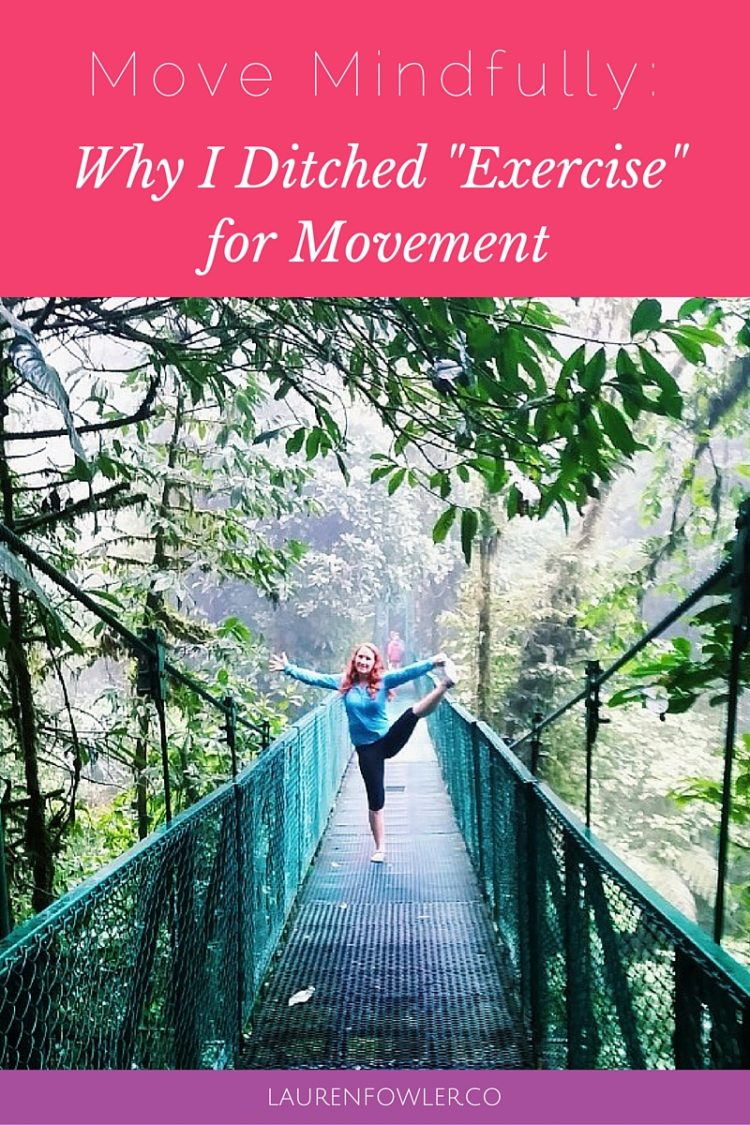FTC Disclosure: Delicious Obsessions may receive comissions from purchases made through links in this article. As an Amazon Associate I earn from qualifying purchases.Read our full terms and conditions here.
{Note from Jessica: Today’s post is shared by my good friend, Lauren, author of Lauren Fowler. She is a Registered Dietitian Nutritionist (RDN) and yoga teacher who promotes a non-diet approach to nutrition and health. She wants everyone to connect to their bodies intuitive wisdom rather than following diets. She encourages the tools of intuitive eating and health at every size. Stop by LaurenFlower.co to read more about nutrition, intuitive eating, heart-based health, and yoga.}
Even just a few years ago, I had a weekly plan for my exercise. I had been a runner since high school (and a little bit before), so I’d plan out my weekly mileage and stick to it. Typically, it would be all running with maybe a yoga class thrown in there to stretch out tight hips and hamstrings.
While I loved running (and still do!), my body started to break down after running a marathon and trying to maintain a high mileage while also working in a busy hospital full-time (and stressed out). My legs were lead, my body was tired, and I wasn’t as motivated to run.
So, I gave my running shoes a break for awhile. I let myself move when I wanted – sometimes going to the gym, taking a yoga class – but more often than not, I would head outside to walk.
It was exactly what my mind and body needed, and it ended up being the end of “exercise” for me. I decided that I didn’t need a rigid schedule with an exercise plan. I already loved to move my body, and when I gave myself a break, I moved pretty intuitively. I didn’t want to lay around on the couch, and I truly wanted to head to a yoga class or go outside for a walk. Some weeks, I spent more time watching Netflix inside while other weeks, I was moving all the time.
Our bodies are made to move, and it feels good (endorphins!) to move. Yet, so many of us put rules and limitations around exercise. We decide what we “should” do (lift weights, go to the gym, run marathons) and what “doesn’t count” (like walking).
It’s all movement.
It’s okay to move with the sole purpose of feeling good.
Everyone will enjoy moving in a different way. I love running, hiking, and yoga, but you’ll never see me running on a treadmill or in a Crossfit class. Whatever you really like to do, great, do that!
When we switch the focus to movement, it’s more expansive. It can mean a planned workout or class, or it can mean moving your body in any way, like walking, hiking, jumping on a trampoline, and dancing.
While exercise tends to focus on burning calories, getting toned, and staying fit, the movement is about much more. Movement can be a space to get creative, like in a vinyasa yoga class or dancing around your house. It can be a time to express or work through emotions – emotions are simply energy in motion, and movement is a go-to for me when I need clarity of mind.
Instead of focusing on the external body appearance, movement can be a space for body awareness. Through movement, you can tune into how your body feels, connect to your body, and build deeper trust with it. That may lead to better body image or translate towards trusting yourself in other aspects of your life.
Movement can be a healing practice for the body and self-care practice. My personal yoga practice helped me calm down immensely, reduce anxiety, and lead to a better body image. Therapeutic yoga has been shown to be an effective part of treatment for a number of disorders for physical and mental health. It doesn’t have to be yoga either – getting outside for walks or hikes are extremely therapeutic as well. You’re moving your body as well as connecting to nature. My favorite term I’ve heard for this is “forest bathing” because it really is that soothing.
Movement is intentional. Through developing a movement practice, it requires deep listening to your body. While our culture has a “no pain, no gain” mindset, I take a more intentional mindset focused on honoring your body’s cues.
Movement may bring discomfort or challenges, but it should never feel painful. If you’re exhausted before, during, or after moving your body, that could be a signal to rest or practice a more restorative form of movement.
It’s tuning into what you need today because that’s always changing each moment, day, time of the month, or season of the year. It’s intentionally giving yourself regular rest to restore your mind and body, as well as taking more time off if you are injured.
Through a movement practice, I feel connected to my body. I feel strong and powerful in mind, body, and heart. I can trust and honor my body’s cues for movement, rest, or if it wants a strong practice or a restorative one. I move because it’s a form of self-care for me and a moving meditation. It’s creative, playful, fun, and feels really good.
I feel so grateful to have reached a place now where it never crosses my mind how many calories my practice burned, and I never feel guilty about resting or not hitting the gym. My movement practice energizes and nourishes my body, so I can do the things I love in life – movement-based or not!

